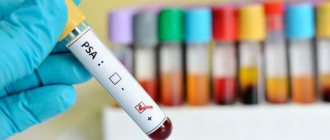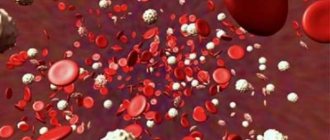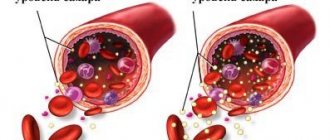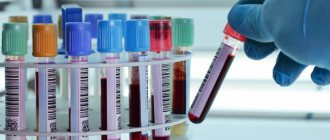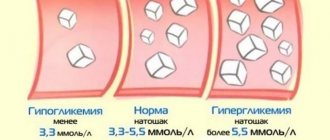What do the letters mean in the transcript of biochemical analysis?
If blood biochemistry is examined, a person receives a result that contains many abbreviations and abbreviations.
To correctly decipher the analysis, you need to know what the letters indicated on the standard form mean. The following indicators are studied during biochemical research:
- G.L.U. Stands for glucose. Its value provides an assessment of the functioning of the human endocrine system. An increase in this indicator indicates a pre-diabetic state, gestational, first or second type of diabetes. Glucose is responsible for carbohydrate metabolism;
- HGB (Hb). Means hemoglobin. The normal value varies from 120 to 140 g/l. Responsible for transporting carbon dioxide and oxygen to organs. Takes part in correcting pH levels. Gives a characteristic of hemoglobin concentration in a whole portion of blood. A low value indicates anemia, lack of folic acid or iron. Inflated parameters are a sign of blood thickening, intestinal obstruction, burns, physical fatigue;
- HCT(Ht). Denotes hematocrit. Indicates the ratio of red blood cells to serum. Does not reflect the total size of red blood cells. Its optimal value for women is 35-45%, for men – 39-49%. Increases with diabetes mellitus, congenital heart defects, diarrhea, vomiting. Decreases with anemia, pregnancy (starting from the fifth month of pregnancy);
- R.B.C. By RBC, doctors mean the number of red blood cells. For women, the optimal value is at the level of 3.8-5.5x1012/l, for men – 4.3-6.2x1012/l, for children – 3.8-5.5x1012/l. Red blood cells are disc shaped. These are red serum cells. They transport oxygen to organs and tissues and transfer carbon dioxide to the lungs. A decrease in the indicator indicates anemia, deficiency of vitamins B12 and B9, and significant blood loss as a result of injury. Red blood cells increase with inflammation, dehydration, alcohol poisoning, smoking, physical overload;
- W.B.C. This is the number of white blood cells in the serum. They are formed in the bone marrow and lymph nodes. The optimal value varies between 4.0-9.0 × 109/l. These are white blood cells. They are responsible for supporting the immune system. Deviation from the norm indicates the progression of inflammation;
- PLT. Indicates platelet count. These are blood elements that prevent blood loss. They take part in the formation of blood clots. The optimal value is 180-320×109/l. A decrease in the indicator indicates that a person has a tendency to bleed;
- LYM. In the biochemical analysis form, you can see two values: LYM% (LY%) and LYM# (LY#). The first is deciphered as the relative content of lymphocytes, the second - as the absolute. The standard LYM% is 25-40%, LYM# – 1.2-3.0x109/l. Lymphocytes are responsible for the production of antibodies and immunity to various microorganisms and viruses. Exceeding the standard indicates lymphocytic leukemia, tuberculosis, and infectious pathology.
Interpretation of a general blood test for adult men and women
A complete blood count is one of the most common services used to assess health status.
In order for the test results to be as reliable as possible, it is necessary to properly prepare for their delivery.
You can get advice on the results of the research performed at a free consultation with a specialist.
If necessary, you can receive medical services without leaving your home.
Save on medical services by becoming a member of a special discount program.
Quality control of clinical laboratory tests, carried out according to international standards, is a powerful argument when choosing a medical center.
A complete blood count is one of the most common and most necessary diagnostic tests. It allows the doctor to assess the patient’s blood counts and quickly draw initial conclusions about his condition.
Latin notation in general analysis
A general blood test is the first test for which a competent doctor prescribes a referral to check the general condition of the patient’s body. In the presence of inflammation or an oncological process, the composition of the blood according to the results of a general examination will have deviations from the norm.
On the general analysis form you can see the following symbols in Latin:
- Hgb. This is hemoglobin. The norm for females is 120-140 g/l, for males – 130-160 g/l. Decreased with anemia, kidney problems, internal bleeding. Increases with dehydration, heart failure, pathologies of the blood system;
- Rbc. These are red blood cells. They contain hemoglobin. The standard for women is 3.7-4.7x1012/l, for men 4.0-5.1x1012/l. The concentration decreases with blood loss, anemia, chronic inflammation, and in late pregnancy. The level of red blood cells increases in diseases of the lungs, bronchi, kidneys, heart, liver, and when treated with hormone-containing drugs;
- Wbc. Denotes white blood cells. The norm for both sexes is 4.0-9.0x109/l. The rate decreases when there is a viral infection in the body, or when taking anticonvulsants and analgesics. The number of leukocytes increases during infections, inflammation, allergies, and neoplasms. Taking cardiac and hormonal medications also helps to increase this indicator;
- Plt. These are platelets. Their optimal value is 180-320x109/l. The concentration decreases in case of poisoning, hormonal imbalance, liver pathologies, spleen diseases, when taking diuretics, antibiotics, hormones, nitroglycerin. An increase is observed during inflammation, in the postoperative period;
- ESR. Stands for erythrocyte sedimentation rate. Shows the course of the disease. The optimal value is 2-15 mm/h for women, 2-10 mm/h for men. The level decreases with poor blood circulation and anaphylactic shock. ESR increases in the presence of infection, inflammation, hormonal imbalance, anemia, and kidney problems. During pregnancy, this figure also increases.
Analysis transcript
The normal blood glucose level is 3.8–5.5 mmol/l or 70–100 mg/dl. When analyzing glycated hemoglobin, the normal glucose level is in the range of 4–6%.
Hyperglycemia
Increased levels of glucose (sugar) in the blood are called hyperglycemia. A temporary (physiological) increase in glucose levels can occur after physical overload, anxiety, stress, or smoking. Hyperglycemia is considered a symptom of a disease when high sugar levels are noted in several independent tests.
Glucose levels increase in the following diseases:
- diabetes mellitus is a pathology of the endocrine system that occurs when there is insufficiency of insulin (a special pancreatic hormone that takes part in glucose metabolism); other signs of diabetes mellitus - changes in body weight, thirst, increased urination, slow wound healing;
- pheochromocytoma is a disease of the endocrine system in which increased amounts of the hormones adrenaline and norepinephrine are released into the blood; other signs of pheochromocytoma are a sharp increase in a person’s blood pressure to very high values, rapid heartbeat, a feeling of fear, sweating;
- diseases of the endocrine system, in which the level of hormones that promote the release of glucose into the blood increases; such diseases include Cushing's disease or syndrome (pathology of the pituitary gland), thyrotoxicosis (pathology of the thyroid gland);
- chronic liver diseases such as hepatitis, cancer, cirrhosis;
- diseases of the pancreas – chronic or acute pancreatitis, pancreatic tumor;
- taking certain medications, for example, diuretics, oral contraceptives, steroidal anti-inflammatory drugs.
Hypoglycemia
A sharp decrease in blood glucose is called hypoglycemia.
Causes of hypoglycemia:
- extremely low caloric intake; in this case, glucose is absorbed by the body without residue;
- the presence of long breaks between meals;
- intense sports activities;
- abuse of sweet foods; when sweet foods enter the body, glucose quickly rises in the blood, causing excess insulin production followed by a sharp decrease in glucose levels;
- consumption of alcoholic and carbonated drinks.
Glucose levels below normal in a blood sugar test often occur in those who follow a strict diet for a long time. Symptoms of low blood glucose include sweating, paleness, trembling, rapid heartbeat, anxiety, lethargy, fainting, irritability, and extreme hunger.
Reasons for the increase in indicators
Sustained hyperglycemia is the main symptom of diabetes mellitus. The disease is classified into two main types. The first (insulin dependent or juvenile). Formed in childhood or adolescence due to hereditary predisposition or activation of autoimmune processes. Characterized by a failure of the endocrine pancreas to produce insulin.
The second (insulin-independent or insulin-resistant). Occurs in adults aged 30+ under the influence of bad habits and excess weight. A distinctive feature is the stable production of insulin against the background of the inability of body cells to adequately perceive and use the hormone.
Hyperglycemia in diabetic patients
Excessively high blood sugar in diabetics is a consequence of:
- Violations of dietary rules.
- Incorrect use of glucose-lowering drugs.
- Refusal (missing an injection) during insulin therapy.
- Nervous shocks.
- Physical activity that does not correspond to the patient’s capabilities.
Diabetics often experience sugar spikes in the morning. Fasting hyperglycemia, or the so-called dawn syndrome, occurs when overeating, the presence of infections, or an insufficient dose of insulin administered before bedtime. In children, this phenomenon is due to the active production of growth hormone (somatotropin) in the morning.
Pathological causes of hyperglycemia
In people who do not have diabetes, an increase in blood glucose may be associated with the presence of other diseases:
- Chronic infections affecting metabolic processes.
- Diseases of the hepatobiliary system (in particular, the liver).
- Pathologies of the pancreas.
- Hormonal imbalance.
- Obesity.
- Postoperative period after surgical intervention in the gastrointestinal tract (gastrointestinal tract).
- Chronic alcoholism.
- TBI (traumatic brain injury) affecting the hypothalamus region of the brain.
Overweight people are most susceptible to prediabetes and diabetes.
Exacerbations of diagnosed cardiovascular diseases can increase sugar levels.
Physiological causes of increased glucose levels
In a healthy person, an increase in sugar occurs under the influence of the following factors:
- Distress (permanent neuropsychological tension).
- An abundance of simple carbohydrates (confectionery, sweet drinks, baked goods, etc.) in the daily diet.
- Incorrect therapy with hormone-containing drugs.
- Excessive passion for alcoholic beverages.
- Polyavitaminosis of vitamins B and D.
Hyperglycemia in women
In women, blood glucose concentrations often increase during the perinatal period. Hyperglycemia in the second half of pregnancy can be caused by:
- Changes in hormonal status. Active synthesis of the sex hormone progesterone and endocrine hormones of the provisional organ (placenta) blocks the production of insulin.
- Overstrain of the pancreas. A pregnant woman's body requires more glucose to provide nutrition for the baby. In response to the increased supply of sugar, the pancreas is forced to increase insulin production. As a result, insulin resistance develops—cell immunity to the hormone.
This condition is diagnosed as GDS (gestational diabetes mellitus). This is a pregnancy pathology that requires timely diagnosis and treatment. Otherwise, there is a risk of abnormal fetal development, complicated delivery, and negative consequences for the health of the mother and child. Another reason for the increased sugar content in women is the hormonal changes in the body during menopause.
At the age of 50+, the production of sex hormones (progesterone, estrogen) and thyroid hormones, which take an active part in metabolic processes, sharply decreases. At the same time, the pancreas increases insulin production during menopause. Hormonal imbalance prevents stable metabolism, which provokes insulin resistance.
Even without a significant deterioration in health during menopause, it is recommended to regularly monitor blood sugar levels
Causes of hyperglycemia in children
Increased glucose in children is observed in type 1 diabetes mellitus, due to an unbalanced diet (abuse of sweets and fast food) against the background of low physical activity, and in a state of stress. In newborns, elevated sugar levels are most often a consequence of active therapy with glucose injections given to underweight infants.
Blood chemistry
A biochemical analysis is a subtype of a general blood test and is carried out in cases where deviations from normal values were detected in a general blood test. The analysis allows you to clarify the diagnosis or adjust the prescribed treatment. In a biochemical blood test, the designations are a letter abbreviation or a general name for the indicator. Let's consider the decoding of the designations of a biochemical blood test:
- Total protein. It represents the total amount of proteins in the blood; it is involved in blood clotting and the transport of various substances to organs and tissues. Normally it corresponds to values of 64-84 g/l. Exceeding the norm may indicate infections, arthritis, and cancer.
- Glu – glucose. Normally it does not exceed 3.30-5.50 mmol/l. An increase in the indicator signals the development of diabetes mellitus. In the body, glucose is responsible for carbohydrate metabolism.
- Urea. Formed during the breakdown of proteins. Normally it is 2.5-8.3 mmol/l. The value of the indicator increases with kidney diseases, intestinal obstruction, and diseases of the urinary system.
- LDL and HDL indicate the level of cholesterol in a biochemical blood test, which takes part in fat metabolism, the production of vitamin D, and affects the functioning of sex hormones. The normal limits are 3.5-6.5 mmol/l. This indicator increases with atherosclerosis, cardiovascular diseases, and liver diseases.
- BIL - bilirubin. The pigment is red-yellow in color and is formed after the breakdown of hemoglobin. Total bilirubin consists of indirect and direct bilirubin and normally corresponds to values of 5-20 µmol/l. A strong increase in the indicator indicates a lack of vitamin B12, the development of jaundice, and cancer.
- Creatinine. It is an indicator of kidney function and takes part in the energy metabolism of tissues. The normal level depends on the person’s body weight and is 53-115 µmol/l. As a rule, an increase in this indicator indicates renal failure.
- α-amylase, amylase – amylase. Promotes the breakdown and digestion of carbohydrates. The normal value for α-amylase is 28-100 units/l, for pancreatic amylase – 0-50 units/l. An increase in the indicator may indicate peritonitis, pancreatitis, diabetes mellitus and some other diseases.
- lipase - lipase. Pancreatic enzyme that breaks down fats. Normally it does not exceed 190 units/l. When deciphering the designations of a biochemical blood test, an increase in the indicator will indicate the development of pancreatic diseases.
- ALT (ALT) – alanine aminotransferase. A special enzyme used to diagnose liver function. ALT appears in the blood if the cells of the liver, heart, and kidneys are destroyed. Normally, the indicator should not exceed 41 units/l. in men and 31 units/l. among women.
We have given a breakdown of the designations of a biochemical blood test in relation to the most common and standard indicators. Along with these designations, other indicators are found in the blood test for biochemistry: gamma-GT, alkaline phosphatase, LDL (low-density lipoprotein), triglycerides, K+ (potassium), Na (sodium), Cl (chlorine), C-reactive protein , iron. These values, deviating from the norm, may also indicate disorders in the human body.
As you can see, knowing the designations in blood tests and the boundaries of normal values, you can independently determine whether the indicator is within the normal range. However, do not forget that only a doctor can make a correct interpretation of the analysis.
Why do blood sugar levels change?
The body regulates What Is The Normal Blood Sugar Level? the amount of glucose in the blood using:
- enzymes that help break down carbohydrates in the intestines and thus affect the rate at which glucose enters the bloodstream;
- hormones that determine how quickly body cells take up sugar from the blood.
The necessary enzymes are produced by the pancreas. It also produces insulin, a key hormone that allows cells to absorb glucose. If there is too little insulin or, for example, cells stop responding to it for some reason (this is called insulin resistance), blood sugar levels rise. In the first situation they talk about type 1 diabetes, in the second - about type 2 diabetes.
Glycemia is also affected by work:
- liver and kidneys, which cleanse the blood of excess glucose and remove the substance from the body;
- thyroid gland: the hormones it secretes determine the rate at which cells consume sugar from the blood;
- adrenal glands This paired endocrine gland also produces hormones (for example, adrenaline), which determine the metabolic rate.
Blood test decoding of Latin letters and designation
Before you begin deciphering a blood test, you should understand the terminology. Blood is a connective tissue of the human body that has a liquid molecular structure. Plasma and the cells suspended in it: leukocytes, erythrocytes and platelets are the most liquid medium of human blood. Under the influence of the constant rhythmic contraction of the heart, every second circulation occurs throughout the entire human vascular system. The mass fraction of blood to the total weight of a person averages about 7%. Everyone knows that blood is red or dark red in color.
This is necessary to identify certain symptoms of the disease and establish an accurate diagnosis. When deciphering laboratory data, a complete picture of the state of blood in the body is revealed. As a result, by conducting a biochemical blood test, it is possible to accurately determine the methods and methods of treatment. There are many different notations that are used when decoding. It is not at all necessary for an ordinary person to know all the ciphers and codes. There are specially trained people for this. However, for a general understanding, you can consider some of them.
Detailed analysis
In a detailed analysis, you can track blood glucose levels for a period of up to 3 months. If its amount exceeds the established norm (6.8 mmol/l), then a person may be diagnosed with diabetes mellitus. However, low sugar levels (less than 2 mmol/l) are dangerous to health and sometimes cause irreversible processes in the central nervous system.
Often, the results of the analysis are revealed by the percentage of the level of hemoglobin and glucose molecules. This interaction is called the Maillard reaction. With increased blood sugar, the level of glycated hemoglobin increases several times faster.
What threatens the body with increased glucose?
An increase in blood glucose may not manifest itself in the form of tangible symptoms for a long time. Many people begin to pay attention to the deterioration of their health only when their sugar level exceeds 10 mmol/l. Meanwhile, even a slightly elevated blood glucose level can be dangerous. Destructive processes occur slowly in the body. Excess glucose that the body cannot process enters the blood. As a result, the vessels are primarily affected. This leads to problems in the functioning of many organs, since their nutrition through damaged vessels is disrupted.
The entire body suffers from the destructive effects of excess sugar. When large vessels are damaged, atherosclerosis develops, which leads to heart failure and an increased risk of myocardial infarction and stroke. Very often the small vessels of the eyes are affected, which affects vision up to the development of blindness in severe cases. When the blood vessels of the kidneys are damaged, renal failure occurs.
Nerves also suffer from excess glucose. As a result, nerve conduction is disrupted.
If elevated blood glucose levels are detected, then urgent measures are needed. At a minimum, a low-carbohydrate diet is prescribed, and glucose-lowering medications or insulin injections may also be prescribed. Treatment methods depend on the type, stage and characteristics of the disease.
If urgent measures are not taken, then sugar continues its destructive effect. Metabolism becomes more and more disturbed, which can cause severe deterioration of the condition, even leading to diabetic coma.
Designation of sugar in loading analysis
The designation in each analysis is carried out using the Latin symbol for glucose Glu. As already presented above, 3.3-5.5 mmol/l is considered the standard. With biochemical testing, the indicators change slightly, depending on how old the particular patient is. However, these details can be safely considered insignificant and not taken into account; they are important only for specialists and are needed in some extreme cases, when the indicator is on the border.
Sometimes it is necessary not only to examine the blood, but also to take load data for comparison. This means that before the test a person engages in a certain physical activity, this must happen under the supervision of doctors in complete safety. Often this test adds additional accuracy to the results.
The indicator can reach up to 7.8 mmol/l and this will not be considered a definite diagnosis if a load was given during the test; it is important to adjust the treatment if the number is 11 or more. Elevated glucose levels are primarily a loud signal that the body is already beginning to suffer from diabetes.
Sometimes a lower level occurs. It is extremely rare, but the lower limit of normal or even a strong decrease means a serious drop in glucose, which can be caused by poisoning
Elevated glucose levels are primarily a loud signal that the body is already beginning to suffer from diabetes. Sometimes a lower level occurs. It is extremely rare, but the lower limit of normal or even a strong decrease means a serious drop in glucose, which can be caused by poisoning.
It is necessary to conduct glucose tests regularly, especially for those people whose grandparents had similar problems. In addition, for example, a biochemical study can tell in detail about the state of the body and can provide data on other diagnoses
This easily helps to pay attention to the disease in a timely manner and begin effective treatment on time.
- Privacy Policy
- Terms of use
- Copyright holders
- Adenoma
- Uncategorized
- Gynecology
- Thrush
- About blood
- Psoriasis
- Cellulite
- Ovaries
How to reduce blood glucose?
- Proper nutrition. This means giving up sweets, flour and confectionery products. Consumption of sugar-lowering foods: cabbage, Jerusalem artichoke, zucchini, cucumbers, pumpkin, celery, beans, blueberries, grapefruits, buckwheat, barley, oatmeal. In addition, you should eat little but often, 5-6 times a day.
- Physical activity. This is a must. You shouldn’t exhaust yourself, but jogging, cycling, fitness or dancing have a very positive effect on the overall tone of the body, improve your mood and “burn” excess glucose in the blood.
- Quitting alcohol and smoking. Drinking alcohol and smoking increase sugar levels. Also, due to these bad habits, there is an additional consumption of vitamins and minerals, which leads to depletion of vitality and further harms the body weakened by excess sugar.
That is, we can say that to a greater extent it is the lifestyle that influences the state of the body and the blood parameters that reflect this state.
Why is glucose determination needed?
Blood sugar is the main indicator reflecting the functioning of carbohydrate metabolism in the human body. A whole cascade of organs and systems is responsible for carbohydrate metabolism in the body, so that the level of glucose in plasma and hemoglobin can be used to judge the functional activity of organs and systems such as the pancreas, liver, and neurohumoral system.
Monitoring plasma glucose levels is especially important in people suffering from various forms of diabetes mellitus. In diabetes, there is a disruption in the production of basal insulin, the hormone responsible for the utilization of glucose, which leads to the accumulation of the latter in the blood, while the body's cells literally begin to starve and experience an energy deficit. For patients with insulin-dependent diabetes, constant monitoring of blood glycemia is vital, since an overdose of insulin or its deficiency significantly affects the progression of diabetes. Only with the help of constant determination of sugar is it possible to maintain glucose in optimal values.
When is blood glucose high?
- For diabetes mellitus,
- For disorders in the endocrine system,
- For acute and chronic pancreatitis, some diseases of the liver and kidneys, pancreas,
- As a result of arsenic or alcohol poisoning, as well as an overdose of certain medications,
- Under severe stress.
Signs of increased glucose:
- Feeling of constant dryness in the mouth,
- Frequent urination,
- Increased amount of urine
- Weakness, increased fatigue,
- Poor healing of scratches, wounds,
- The appearance of pimples, boils,
- Skin itching
- Frequent headaches
- Deterioration of vision,
- Decreased immunity.
If at least two or three of the listed signs appear, you need to consult a doctor and be sure to do a blood test for glucose to identify a possible disease.
Blood sugar test is normal and prediabetes
So we got a blood test. The normal fasting glucose level is no higher than 5.6 mmol/l. The threshold value for diagnosing diabetes mellitus is 7.0 mmol/l and above. What's in between?
And a few more simple rules that will be useful for those who have elevated glucose levels:
- Eat raw vegetables and fruits; adding butter and sour cream to salads increases their calorie content.
- Choose products with low fat content. This applies to yoghurts, cheese, cottage cheese.
- Try not to fry foods, but to boil, bake or stew them. Such processing methods require less oil, which means the calorie content will be lower.
- “If you want to eat, eat an apple. If you don’t want an apple, you don’t want to eat it.” Avoid snacking on sandwiches, chips, nuts, etc.
How to know if your blood sugar level is abnormal
It is almost impossible to do this without a blood test. The fact is that the characteristic symptoms of a decrease or increase in glucose levels can easily be confused with ordinary fatigue or, for example, a reaction to weather changes.
In order not to miss developing hypo- or hyperglycemia and the diseases that caused it, doctors - both Western Blood sugar test and Russian Memo on the prevention of diabetes mellitus. Prevention of diabetes in men, women and children - it is recommended to regularly test your blood sugar levels.
You need to donate blood for sugar testing at least once every three years. This is especially important for people over 45 years of age.
In addition, it is recommended to do the analysis as quickly as possible if you have signs of diabetes:
- urination becomes more frequent;
- you have gained a lot of weight;
- your vision is deteriorating;
- Weakness regularly sets in, even to the point of darkening of the eyes.
What are the names of the types of sugar tests, what are they carried out and what do they mean?
As a rule, a blood sugar test is taken by pricking a finger with a metal disposable needle. If you take blood from a vein, then the norm will be 12% higher, because a certain amount of glucose has already gone into the cells from the capillaries, and sugar has nowhere to go from large vessels. There are several types of studies of this kind, but the most reliable is considered to be a standard laboratory analysis, which is carried out in all medical institutions.
Normal capillary blood levels are 3.3–5.5 mmol/liter, venous blood is 6.1 mmol/liter. If blood from a finger on the analysis form shows a sugar concentration above 5.5 units, then there is a risk of developing prediabetes, and values above 6.1 mmol/l for capillary and 7 mmol/l for venous blood are already a reason to diagnose diabetes mellitus " Blood sugar levels are the same for children, adults and the elderly.
Standard laboratory analysis and rapid test
The main blood tests for sugar are laboratory and express methods. A standard study is carried out in a clinic on the direction of a doctor in the morning on an empty stomach, piercing the finger with a special needle. There is also a rapid test that involves measuring sugar using a portable glucometer. This method is accurate provided that the batteries are new, the device is in full working order and the test strips are stored correctly. Glucometers are freely sold in pharmacies at an affordable price, which gives people with diabetes the opportunity to monitor their glucose levels at home.
If the doctor orders a stress blood test, this means that two tests will be performed. First, they will take a basic laboratory blood sample for sugar in the morning on an empty stomach, and then give 100 grams of glucose in the form of syrup or tablets. A couple of hours after taking glucose, another test will be taken. In this case, blood is taken from a vein, as it gives more accurate indicators of fluctuations in sugar levels.
Glycated hemoglobin
There is also an analysis that allows you to accurately determine the amount of hemoglobin associated with glucose molecules, and it is called the glycated hemoglobin test. It helps determine how successful the treatment of diabetes mellitus is, and to carry it out, blood is taken from the patient at any time of the day. Patients undergo this analysis weekly for 3 months. Watch the video for a more detailed description of this study:
Glucose tolerance test
To refute or confirm the diagnosis, additional tests are performed, for example, a glucose sensitivity test, when a person’s blood is taken four times within two hours: the first on an empty stomach in the morning, the second an hour after the person drinks 75 grams of glucose, and then every half hour. Doctors evaluate the sampling results throughout the test.
Analysis for sugar and cholesterol
High levels of sugar and cholesterol will be shown by a biochemical blood test, which is used in all areas of medicine, reflecting the functional state of all systems and organs. The sample for this study is taken from a vein on an empty stomach. Before this, you cannot brush your teeth or take medications the day before, and in the early morning you are prohibited from drinking or eating anything. Biochemical analysis shows not only the level of cholesterol and sugar, but from it doctors find out the level of urea, protein, creatinine, transaminase, and all minerals: sodium, magnesium, calcium, potassium and others.
Determination methods
A basic test for sugar content is carried out by collecting venous or capillary (from a finger) blood on an empty stomach. In case of deviations from the norm, extended blood microscopy is prescribed, including:
Blood sugar measuring devices
- GTT (glucose tolerance testing).
- HbA1C analysis (assessment of glycated hemoglobin concentration).
Using a glucose tolerance test, the level of glucose absorption by the body's cells is determined. The analysis is carried out in two stages: an initial blood sample on an empty stomach, and a second blood sample two hours after exercise. As a load, the patient drinks an aqueous solution of glucose (75 g per 200 ml of water). The results are assessed through comparison with standard indicators.
Glycated (glycosylated) hemoglobin is the result of the interaction of glucose and protein (hemoglobin). HbA1C analysis evaluates sugar levels in retrospect, over the past 120 days - the lifespan of red blood cells. The HbA1C test result is determined according to the patient's age. The normal indicator up to 40 years is
| Age | Norm | Limit level | Deviation | ||
| 40+ | <7,0% | 7,0–7,5% | >7,5% | ||
| 65+ | <7,5% | 7,5–8,0% | >8,0% | ||
If glucose tolerance is impaired, prediabetes is diagnosed - a condition in which sugar levels are consistently elevated, but do not “reach” the norms for diabetic values. Prediabetes is not an official disease, but nevertheless requires emergency treatment to prevent true type 2 diabetes from developing.
What is the name of the blood test for diabetes mellitus and its types?
Have you been struggling with DIABETES for many years without success?
Head of the Institute: “You will be amazed at how easy it is to cure diabetes by taking it every day...
However, not all patients know what a blood test for diabetes is called (which causes particular difficulties in cases where the patient wants to independently do a sugar test in a commercial laboratory without consulting a doctor).
Types of research
Blood glucose levels can be determined using a test. The simplest is to analyze the sugar in the sample. A urine test is often prescribed as an additional measure. The easiest way to find out your blood sugar is by taking a finger prick sample using a home glucometer and test strips. If you receive an inflated result, you must consult a doctor to prescribe additional tests and make a diagnosis.
- The glucose tolerance test is carried out “with a load”. A fasting sample is taken from the patient, then he drinks 75 ml of glucose diluted in 300 ml of water. Half an hour, an hour, one and a half and two hours after this, the sample is taken again. As a result, we can draw a conclusion about the dynamics of accumulation and assimilation of carbohydrates. A laboratory assistant or doctor writes a conclusion about this and makes a diagnosis based on it;
- A test for glycated (associated with glucose compounds) hemoglobin is not always prescribed. More often used as an additional study. Its content in a blood test shows how much glucose has been released into it recently. On the results form, its designations range from its simple name to the abbreviation HbA1c;
- Test morning urine for the content of glucose compounds. The level of sugar in urine is zero, i.e. they are absent. The designation on the form is “Glucose”, rarely “Glu”;
- A 24-hour urine test is prescribed when glucose was detected in the previous type (as well as in a blood test). In this case, a 150 ml sample is collected from all daily urine and analyzed for glucose;
- Urine examination for the presence and concentration of ketone bodies. Ketone bodies are formed as a result of the burning of fat deposits, which occurs when cells do not receive enough glucose to be converted into energy. There is no such indicator in a blood test.
Order the necessary research and tell us what the test for diabetes mellitus is called, which is the most necessary and informative in this case. If there are deviations in the indications, it is better not to self-medicate, but to immediately seek qualified help.
Diagnostic methods
In medical practice, it is customary to determine an increase in glucose by examining capillary blood, which is donated on an empty stomach. There are several types of laboratory tests: express method, analysis under the influence of glucose load, determination of glycated hemoglobin indicators, laboratory blood test. The latter diagnostic method will most accurately detect an increase in glycemic levels.
Before the analysis, it is necessary to prepare the body; it is necessary to comply with certain requirements: donate biological material on an empty stomach (eat no later than 8 hours before the test, drink exclusively clean water, without sugar), 24 hours before donating blood, stop drinking alcohol, which increases blood sugar. blood.
Another recommendation is that immediately before donating blood, it is better not to chew gum or brush your teeth. The day before the test, stop taking medications that increase or decrease sugar levels, for example, nootropics. If such treatment cannot be refused, inform the doctor.
Carbohydrate Load Analysis
The essence of the study is as follows. The patient donates blood 4 times within 2 hours, the first sample is taken in the morning on an empty stomach, then they drink 75 g of glucose and repeat the analysis an hour later. After this, 30 minutes later the analysis is done again.
It is a normal reaction of the body if the first test shows a reduced sugar level. The first portion of carbohydrates increases glucose levels, after which the numbers should decrease.
Glycated hemoglobin
The result of this test indicates the average blood sugar reading for the last 3 months. The amount of glucose depends on the following factors:
- reaction rate of blood cells, glucose;
- production of glycated hemoglobin.
This study will indicate the effectiveness of the prescribed course of treatment and the adequacy of the recommended dosages of drugs. Blood is taken from a finger at any time of the day.
Additionally, a patient with type 2 and type 1 diabetes is tested for urine sugar. If glucose in the blood is significantly increased, then there will be traces of it in the urine.
However, there is also an advantage of the express method, because it can be carried out simply at home, without seeking the help of strangers. But there is a possibility that the device for studying glycemic indicators will be faulty and show the wrong result.
In order for the blood glucose level to no longer increase, a person is required to regularly monitor their diet and perform simple physical exercises every day. Prevention is especially important when one of your relatives has:
- metabolic disorders;
- the hormone insulin is not produced in the proper amount;
- increased body weight.
Expert opinion
Shalaeva Svetlana Sergeevna
endocrinologist, highest category, 18 years of experience
It is necessary to note that if there are obvious symptoms of rising sugar, you need to consult a doctor to diagnose the body.

